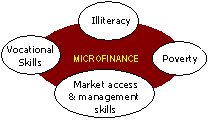|
. |
Microfinance is not Enough ...The cure-all myth of microfinance needs to be debunked with the proverbial pinch of salt. Is microfinance alone enough? Is something missing? A broader perspective needs to be taken so that overall development is not compromised ... |
|||
The excitement of microfinance as a 'new tool' to combat poverty is being tempered by the realization that we need more than just microfinance to undo some of our societies' maladies and the developmental lacks, gaps, and mismatches we are facing. |
|||||
Square peg in a round hole? |
. |
Microfinance is an enabling, empowering, bottoms-up tool to poverty alleviation that has provided considerable economic and non-economic externalities to low-income households in developing countries. Microfinance is being hailed as a sustainable tool to combat poverty, combining a for-profit approach that is self-sustaining, and a poverty alleviation focus that empowers low-income households. Microfinance is increasingly becoming a tool to exercise developmental priorities for governments in developing countries.
But there has been a gradual realization that microfinance alone is not enough. Microfinance is not a replacement for jobs that are not there, markets that are inaccessible, or education and skills that do not exist. Particularly, the main objective of microfinance institutions - poverty alleviation - requires a holistic and indepth understanding of the interplay between economic, social, cultural extracts of the developmental process.
| |||
Problems behind problems |
. |
Understanding the problems, and the cause-effect relationships, is critical for a holistic view of development. There will always be problems behind the problems. For example, some of the commonly cited 'problems' of developing countries, such as high population growth, poverty and very poor people, pollution and bad local environments, or low water resources are indeed effects of deeper problems that lie behind it: lack of political will and leadership, bad development and management practices, inadequate human resources and skills, or improper infrastructure provision and management. Problems behind problems therefore require 'solutions behind solutions' that target the root cause of problems - indeed it is critical for the progression of developmental inputs and solutions to run in parallel in achieving all-round progress. For example, good individual health and good local evironmental conditions are a vital ingredient in improving the quality of life and the productive/economic capabilities of such individuals. But good health, without adequate access to financial resources, to jobs and to incomes, is per se insufficient for development. Conversly, a well designed and well implemented microfinance programme will have little effect if the overall health of the individuals is poor.
|
|||
More than microfinance |
. |  In the long run, access to adequate and appropriate financial resources is critical in solving societal problems such as illeteracy, poverty, lack of skill, inaccessible markets etc.and the real issues that lie behind these issues: lack of political will and leadership, lack of transparency, high graft and corruption, lopsided developmental policies ... etc. Microfinance is indeed an essential ingredient in the development process - but not the only ingredient.
In the long run, access to adequate and appropriate financial resources is critical in solving societal problems such as illeteracy, poverty, lack of skill, inaccessible markets etc.and the real issues that lie behind these issues: lack of political will and leadership, lack of transparency, high graft and corruption, lopsided developmental policies ... etc. Microfinance is indeed an essential ingredient in the development process - but not the only ingredient.
|
|||
| . |
Hari Srinivas - hsrinivas@gdrc.org |


